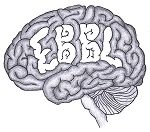One of the most common affective disorders is Major Depressive Disorder, colloquially referred to as depression. This condition affects over 14 million Americans annually (Deng et al., 2014). While there exists a wide variety of treatments and therapies for depression, this blog will focus on a particular intervention, deep brain stimulation, allowing for a discussion on substructures of the brain and neurological pathways leading to the origins of some affective disorders.
What is deep-brain stimulation?
Deep brain stimulation is a surgical procedure in which electrodes are permanently implanted in target tissues within the brain; after implantation a mild current is continuously delivered to the tissues. This technique was first explored when treating Parkinson’s disease, and that research led to exploring the technique’s efficacy for treating depression. The pathological origin of depression was thought to originate in the anterior cingulate cortex (Deng et al., 2014). Further imaging studies, with a heavy reliance on fMRI, further narrowed the area of concern to be the subgenual cingulate white matter, or Cg25WM for short. A current theory is that depression is caused by an increase of brain activity in this area, and that DBS has proven to be effective by inhibiting this activity (Mayberg et al., 2005).

This image shows a sagittal view of the brain (left column) and coronal views (right column), of the areas targeted by DBS techniques, with the lower two images showing the implantation of the electrodes.
The surgery is performed with local anesthesia at the incision site. This is done in part to avoid unnecessary total anesthesia, but also so that the patient can provide active feedback about their mental state and surgeons can ensure they are causing minimal harm. After two electrodes are inserted through the skull and secured, increasing voltages are tested to explore the patients response. In controlled studies, patients reported immediate effects, including feeling calmer and a visual brightening of the room (Mayberg et al., 2005).
When is DBS used?
The use of deep brain stimulation for major depressive disorder is still considered to be in clinical trials. However, as with any treatment, using the right one at the right time is of paramount import. So, when is DBS used?
DBS is used after other treatments have proven ineffective in a patient. Treatments such as psychotherapy, pharmacological treatments or in severe emergent cases, electroconvulsive therapy are always used first (Schlaepher et al., 2013) However, in an estimated 10-30% of cases, patients do not improve with standard care protocols. With pharmaceutical treatments, this can often be due to a patient’s rising level of tolerance (Kennedy et al., 2011).
Contraindications and risks:
Any surgery is a serious procedure with an inherent risk to the patient, and the procedure for implanting DBS electrodes is no different. The most common side-effects are surgical site infections, often at the site of entry to the skull, as electrode leads may be exposed for some period of time after insertion, in case adjustments need to be made. Side effects from the treatment itself are often mild, and usually ameliorated by adjusting the voltage across the brain to better suit the patient and the exact position of the electrodes. (Schlaepfer & Bewernick, 2013).
What’s next?
Deep Brain Stimulation is still a new field, especially for major depressive disorder. It is still being heavily researched, as different areas of the brain are being targeted for maximum effect, in part being driven by advances in imaging technologies. One major drawback is the small number of people involved in clinical trials. As DBS is considered a “last-resort” procedure, results are often not very statistically significant, hiding effects of varying methods.
However, while there is debate as to the efficacy of DBS, several studies have suggested an improvement in the quality of patients lives and a reduction of depressive symptoms. One notable longitudinal study has show remission rates of around 33% after three years. While this was not balanced with a control in this study, average depression remission rates after three years are around 8%, when only receiving standard treatments (Kennedy et al., 2011).
Deep brain stimulation is an exciting area of research as there exists a high potential for future discoveries about the brain. The discussion will continue by examining how deep brain stimulation originated from older invasive methods for psychological disorders, the specifics of current treatments and underlying theories of the pathology of depression as well as ethical concerns with such an invasive clinical procedure.
Works Cited
Deng, Z., Mcclintock, S., Oey, N., Luber, B., & Lisanby, S. (2014). Neuromodulation for mood and memory: From the engineering bench to the patient bedside. Current Opinion in Neurobiology,30, 38-43. Retrieved September 26, 2014, from PubMed.
Kennedy, S., Giacobbe, P., Rizvi, S., Placenza, F., Nishikawa, Y., Mayberg, H., & Lozano,A (2011). Deep brain stimulation for treatment-resistant depression. American Journal of Psychiatry,168, 502-510. Retrieved September 26, 2014, from PubMed.
Mayberg, H., Lozano, A., Voon, V., McNeely, H., Semionowicz, D., Hammani, C., Schwalb, J., & Kennedy, S. (2005). Deep brain stimulation for treatment-resistant depression. Neuron, 45, 651-660. Retrieved September 26, 2014, from PubMed.
Schlaepfer, T., & Bewernick, B. (2013). Brain Stimulation. In A. Lozano & M. Hallett (Eds.),Handbook of Clinical Neurology (Vol. 116, pp. 235-243), from PubMed.
Schlaepfer, T., Bewernick, B., Kayser, S., Mädler, B., & Coenen, V. (2013). Rapid Effects of Deep Brain Stimulation for Treatment-Resistant Major Depression. Biological Psychiatry, 73, 1204-1212. Retrieved September 26, 2014, from PubMed, from PubMed.

I wouldn’t be quick to stand in line for this procedure! Of course, I would likely feel differently in the face of severe, treatment-refractory depression. It’s amazing to me that there are people in the world who can administer such things.
I’m so curious to know more about how emotions change in people who’ve had DBS! It’d be great if someone would do a study using experience sampling methodology to see if the quantity and/or quality of emotions experienced in daily life are altered relative to pre-DBS and/or relative to a control group.